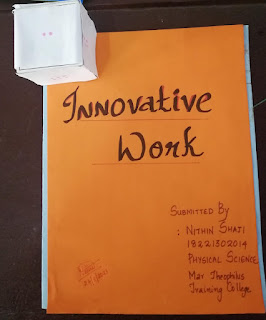Unveiling the Three Laws of Motion: My Journey as a Student Teacher
As a student teacher, I had the privilege of witnessing the power of innovation in the classroom. In particular, I want to share an enriching experience that revolved around an innovative teaching model centered on Isaac Newton's Three Laws of Motion, ingeniously embedded within a scarf book. This unique approach not only piqued students' interest but also made the learning process engaging and fun. In this blog, I will walk you through my journey of implementing this innovative teaching method and its three exciting tasks.
Task 1: The Jumbled Words in the Scarf Book
The foundation of this innovative teaching model lay in a scarf book, which concealed the three laws of motion as jumbled words. Instead of delivering a traditional lecture on these laws, I handed out the scarf books to my students. They were initially puzzled, but their curiosity was piqued. Their task was to arrange the jumbled words into the correct order of the definitions of the laws of motion.
This hands-on, interactive approach allowed students to actively engage with the material. It fostered teamwork as they discussed and debated the correct sequence, providing each other with valuable insights. Not only did they learn the laws of motion, but they also learned problem-solving skills, critical thinking, and the importance of collaboration.
Task 2: Selecting Pictures of Action and Reaction
The second task involved incorporating visuals to enhance the understanding of the laws of motion. To illustrate the concept of action and reaction, students were asked to select pictures that showcased real-life examples of these principles in action.
This task encouraged students to think beyond the theoretical definitions and connect the laws of motion to their everyday experiences. They scoured through magazines, websites, and even took their own photographs to find compelling visuals. This exercise not only made the laws of motion more relatable but also honed their observation and research skills.
Task 3: The Snake and Ladder Game with a Twist
The third and final task took a playful twist on learning. To solidify their understanding of the laws of motion, I introduced a customized Snake and Ladder game. In this version, each number on the die corresponded to a specific task related to the laws of motion.
For instance, if a player rolled a three, they had to explain the third law of motion. If they rolled a six, they would act out a scenario demonstrating the first law. This gamified approach added an element of excitement to the learning process. Students were not only learning but also having fun while doing so.
Conclusion
Implementing this innovative teaching model was a remarkable experience as a student teacher. It not only captivated students' attention but also helped them grasp complex scientific concepts in a memorable way. Through the scarf book, picture selection task, and the unique Snake and Ladder game, the laws of motion transformed from abstract theories into tangible, comprehensible principles.
This experience has taught me the power of creativity in education. Engaging students through innovative methods can turn a mundane lesson into an unforgettable journey of discovery. As I continue my journey in education, I look forward to exploring more innovative approaches to make learning not just informative but also enjoyable for my future students.










.jpeg)


Comments
Post a Comment